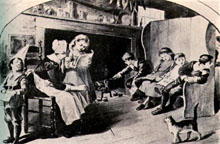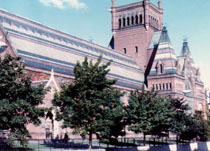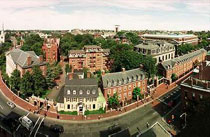|
● Going
to School in America Today
● Education—A Local Matter
● What
an American Student Learns
● Education
in a New Nation
● Learning
to Be World Citizens
● Higher Education
● Selecting
a College or University
● Trends in Degree Programs
● Education for All
Education in a New Nation
 |
|
Eearly Education
|
 Americans
trace the origins of their nation to the English colonialists
(settlers) who came to the eastern coast of North America in the
early 17th century. The largest group of these first colonists,
the Puritans, founded the Massachusetts Bay Colony in 1630. Like
others who followed them to America, the Puritans sought the freedom
to practice their religion—a freedom they could not enjoy in their
native country. They found this freedom in the small towns and villages
they built on the edge of the forest in Massachusetts. Americans
trace the origins of their nation to the English colonialists
(settlers) who came to the eastern coast of North America in the
early 17th century. The largest group of these first colonists,
the Puritans, founded the Massachusetts Bay Colony in 1630. Like
others who followed them to America, the Puritans sought the freedom
to practice their religion—a freedom they could not enjoy in their
native country. They found this freedom in the small towns and villages
they built on the edge of the forest in Massachusetts.
 One
of the things the Puritans believed was that every person should
be able to read the Bible. One hundred percent literacy seemed like
a dream in the 17th century. Within just a few years after their
arrival, they took steps to set up a system of education in their
colony: One
of the things the Puritans believed was that every person should
be able to read the Bible. One hundred percent literacy seemed like
a dream in the 17th century. Within just a few years after their
arrival, they took steps to set up a system of education in their
colony:
In 1634, they opened a "Latin
grammar" school, a school for those who wanted to prepare for
college.
In 1636, Harvard College was
founded for the training of religious ministers.
 |
 |
|
Memorial Harvard
Yard
|
Harvard
|
In 1634 and 1638, the Puritans passed laws declaring that all
property could be taxed for the common good, which included the
support of schools.
In 1642 and 1647, the Bay Colony passed laws requiring all parents
to provide reading education for their children.
 Thus,
in less than 20 years, the Puritans introduced two practices that
still influence American youth: compulsory education for
all children and public taxation for schools. The situation was
different in other British colonies in North America. In Pennsylvania,
for example, where there were several different religious groups,
decisions about education were left to the leaders of each church.
In southern colonies such as Virginia, those who could afford tutors
hired them for their sons (and sometimes for their daughters). The
older sons of wealthy landowners were sent to England for their
education. Occasionally, a landowner might allow a literate adult
to teach reading to the children of poor whites and, perhaps, a
few blacks. But mostly, custom forbade the teaching of children
of slaves to read. Thus,
in less than 20 years, the Puritans introduced two practices that
still influence American youth: compulsory education for
all children and public taxation for schools. The situation was
different in other British colonies in North America. In Pennsylvania,
for example, where there were several different religious groups,
decisions about education were left to the leaders of each church.
In southern colonies such as Virginia, those who could afford tutors
hired them for their sons (and sometimes for their daughters). The
older sons of wealthy landowners were sent to England for their
education. Occasionally, a landowner might allow a literate adult
to teach reading to the children of poor whites and, perhaps, a
few blacks. But mostly, custom forbade the teaching of children
of slaves to read.
 Throughout
the colonies, young men and women could receive an education in
reading by becoming an apprentice in a small business. It
had been a practice in England to have young boys and girls live
with the families of those for whom they worked (bakers, printers,
etc.). In return for a youth's work, the business owner promised
to teach him or her to read, as well as how to do a craft (bake
or print, for example). This practice was brought to North America. Throughout
the colonies, young men and women could receive an education in
reading by becoming an apprentice in a small business. It
had been a practice in England to have young boys and girls live
with the families of those for whom they worked (bakers, printers,
etc.). In return for a youth's work, the business owner promised
to teach him or her to read, as well as how to do a craft (bake
or print, for example). This practice was brought to North America.
 On
July 4, 1776, the 13 colonies issued a Declaration of Independence,
and went to war for their freedom from England. They won the war
for independence in 1781, and negotiated a favorable treaty in 1783.
But it was not until 1789 that they shaped a unified national government.
The shape and power of this new government, described in the Constitution,
were determined after many debates and compromises. The new United
States was to be a federal republic—a union of states with a strong
central government representing all the people. On
July 4, 1776, the 13 colonies issued a Declaration of Independence,
and went to war for their freedom from England. They won the war
for independence in 1781, and negotiated a favorable treaty in 1783.
But it was not until 1789 that they shaped a unified national government.
The shape and power of this new government, described in the Constitution,
were determined after many debates and compromises. The new United
States was to be a federal republic—a union of states with a strong
central government representing all the people.
 The
states did not easily give up their own political powers to this
new central government. In fact, the 10th Amendment was added
to the Constitution to guarantee that "powers not delegated
to the United States by the
Constitution … [would be] reserved
to the [governments of the]
States … ". One of these reserved
powers was the right of each state to provide for the education
of its people. The
states did not easily give up their own political powers to this
new central government. In fact, the 10th Amendment was added
to the Constitution to guarantee that "powers not delegated
to the United States by the
Constitution … [would be] reserved
to the [governments of the]
States … ". One of these reserved
powers was the right of each state to provide for the education
of its people.
 Actually,
at the end of the 18th century, elementary education throughout
the United States was in local hands. State governments were allowing
local districts (small towns and villages) to set up and run their
own elementary schools. Most often, these schools were in one-room
buildings, with one teacher for all the students who could attend.
The teacher, who was hired by a committee of citizens, had to teach
what the local community expected. And so the future was decided:
Education in the United States was to remain in the hands of state
and local governments. Actually,
at the end of the 18th century, elementary education throughout
the United States was in local hands. State governments were allowing
local districts (small towns and villages) to set up and run their
own elementary schools. Most often, these schools were in one-room
buildings, with one teacher for all the students who could attend.
The teacher, who was hired by a committee of citizens, had to teach
what the local community expected. And so the future was decided:
Education in the United States was to remain in the hands of state
and local governments.
Previous Page Next
Page
|

